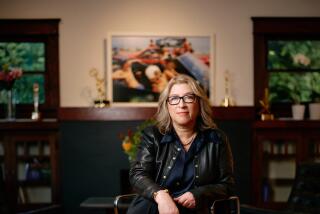Learning How to Do Life
- Share via
Once upon a time, middle-school girls learned to bake apple pie crusts, sew pillows and take a sick person’s temperature in their single-sex course called Home Ec.
These days, they still learn about food and sewing, but they work beside boys in food labs, figuring out such things as how long it takes noodles and egg whites to digest in saliva. They get dating tips, earn baby-sitting certificates, design their own prom wear and learn about self-esteem.
And the class is now called Family and Consumer Science.
Actually, the old Home Economics is no longer a class but a whole field of study: 15 classes from Child Development, Parenthood Today: A Course for Teen Parents and Balancing Work and Family to Fashion Merchandising and Nutrition Science. There’s even an independent study to practice child care on actual children.
This has happened because the two-parent homes of old, in which Mom cooks and Dad earns the paycheck, have been replaced by homes whose doors are unlocked by the children, where the father might stay home or the teenage mother has to raise her kids alone.
Students say the new topics tell them what they need to know.
“What we learn in here we use outside in the world,” says Noah McKechnie, who takes a class called Human Relationships at Magothy River Middle School in Arnold, Md. “It’s kind of loose. It’s kind of fun.”
Louise Parker has taught Home Ec and Family and Consumer Science, or FACS, for 23 years at Magothy. She’s seen the evolution from stuffed-animal patterns to leopard prints. Things definitely are more complicated these days.
Students now study self-esteem and “self-concept,” using what was unheard of until recently--a FACS textbook. To form their “self-concepts,” Parker has her students make collages with magazine cutouts that represent their interests. No surprise that Leonardo DiCaprio showed up on many a page, along with models in bell-bottom jeans and the newest makeup, hair mascara.
In the dating class, Parker must be careful that she teaches the students their parents’ values, not hers. She had her students survey their parents on dating. Among the results: Most parents thought that either the boy or the girl could ask another teen on a date, that the person who does the asking foots the bill, and that 16 is the ideal age to begin.
*
Although Parker tries to prepare the students for the roller-coaster ride of relationships, to practice abstinence, they have tumbled into dating headfirst. Grey Campbell, a 13-year-old eighth-grader who spends his spare time at the mall, tells how he “asked out” a girl named Lindsay. He said, “Lindsay, would you go out with me?” and with that they were a couple--launching the roller coaster.
They had the “power struggles” Parker has taught them about.
“It’s like, she would want to do one thing, and I’d want to do another. I’d kind of take charge, and we’d end up doing what I wanted to do,” he said. But that ended with breaking up: “We got into a big fight because there were rumors going around that I was dumping her for another girl.”
Ah, teenage angst.
Parker’s class is an even mix of boys and girls, whereas a nutrition science class at another Maryland high school was dominated by boys recently.
Clad in blue goggles and gray aprons in teacher Rebecca Atwater’s classroom, Mike Sherman and Marcie Hubbard, both seniors, examined what digests fastest--protein, carbohydrates or fats--when steeped in stomach-like conditions: test tubes of enzymes.
But first they had to simulate stomach-like conditions for the test tube.
“Now let’s heat this bad boy up,” said Brian Cocco, a 17-year-old junior, while he and classmates put the test tubes in a beaker and warmed them to about 98.6 degrees.
The test tube of carbohydrate and saliva became cloudier than the others, showing it was breaking down fastest. The protein broke down more slowly, information of interest to Sherman, 18.
“I’m very concerned about my health,” said the Sean Penn look-alike, who plays soccer and runs track. “I’m a very healthy eater. I wanted to find out how to build muscles, what food contained protein, what exactly protein did.”
He recently typed what he’d eaten into a computer program called Diet Analysis Plus to see whether he was eating healthy. His menu: two cans of tuna fish, two grilled chicken sandwiches, an orange, other snacks.
“It told me I was eating very healthy,” he said.
That’s a concern of lots of FACS teachers, who have changed the recipes for age-old pie crusts and brownies to slash the fat. Some use applesauce instead of oil in baked goods, and one teacher said she was making frozen chocolate shakes using gelatin for thickness instead of ice cream.
Sewing classes are still dominated by girls. But in the old days teachers decided what girls would sew, and now it’s up to the students.
Atwater says she used to limit students to making pillows and jumpers, but “today at the high school level students make their own choices,” from cosmetic bags and vests to prom gowns they design. Her classroom displayed photos of a prom gown and a matching cummerbund and bow tie one student made with curtains she found at Goodwill.
For today’s FACS students, it’s all about function. As Kim Giles, 17, making a blue-plaid skirt in Atwater’s class, says: “To me, it wasn’t whether I get a good grade, but whether I could wear it.”






